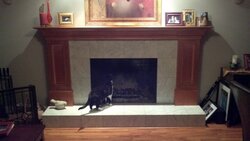First of all, thank you to all of you that have helped me already in figuring out the best stove for my current fireplace. I've finally think I've decided on the Hearthstone Clydesdale. I've got a ton of install questions for you all though. I saw that someone else just recently installed one on here so I am using that as a resource, but also had some of my own questions that I hope you guys can answer for me.
1) My hearth is too shallow for any insert. It's right at 16" which I know needs to be at least 18". What is the best way to extend the hearth. I know there are lots of options. I've thought about just building the hearth out another 8" or so. wouldn't be too terrible to do.
2) Is there a way to determine the current R value of the hearth? I have no idea what the previous owners of the house did and i want to make sure I don't start the house on fire. I know that that used a thing marble tile for the overlay, but I have no idea what went below. I can always pop a front tile off and look I guess, but I was hoping there as an easier way
3) Is it better to have the hearth inserted extended into the room or push it all the way back in the box. The Clydesdale has the option for either. Someone mentioned something about better convection with it extended, but is it worth giving up extra space on the floor for? I can go with either option in my fireplace.
4) Should I wire an electrical box into the fireplace box? I've heard some mixed things about it on here and just wondering if anyone has experience doing that with this insert (I believe the other Clydesdale install on here did that, but I couldn't follow all the details).
5) Can i do this install myself or should I leave it to a pro? I am pretty capable and fixing things and what not, but I am wondering what you guys think in general.
6) Anyone have to pull a permit for an insert install? My building department is telling me I need to, but I don't know if they realize I am putting it into an existing fireplace.
Thanks everyone for all your help! I am really amped about getting this thing installed.
Here is a picture of the fireplace as it stands right now. The cat will be removed from the mantle before any work is done despite his complaints.
1) My hearth is too shallow for any insert. It's right at 16" which I know needs to be at least 18". What is the best way to extend the hearth. I know there are lots of options. I've thought about just building the hearth out another 8" or so. wouldn't be too terrible to do.
2) Is there a way to determine the current R value of the hearth? I have no idea what the previous owners of the house did and i want to make sure I don't start the house on fire. I know that that used a thing marble tile for the overlay, but I have no idea what went below. I can always pop a front tile off and look I guess, but I was hoping there as an easier way
3) Is it better to have the hearth inserted extended into the room or push it all the way back in the box. The Clydesdale has the option for either. Someone mentioned something about better convection with it extended, but is it worth giving up extra space on the floor for? I can go with either option in my fireplace.
4) Should I wire an electrical box into the fireplace box? I've heard some mixed things about it on here and just wondering if anyone has experience doing that with this insert (I believe the other Clydesdale install on here did that, but I couldn't follow all the details).
5) Can i do this install myself or should I leave it to a pro? I am pretty capable and fixing things and what not, but I am wondering what you guys think in general.
6) Anyone have to pull a permit for an insert install? My building department is telling me I need to, but I don't know if they realize I am putting it into an existing fireplace.
Thanks everyone for all your help! I am really amped about getting this thing installed.
Here is a picture of the fireplace as it stands right now. The cat will be removed from the mantle before any work is done despite his complaints.


